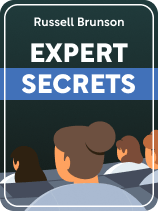
Why should you launch a movement and not just a product? How often should you publish content for your audience? How should your strategy change when you sell to a large group?
Expert Secrets by Russell Brunson answers these questions and many more. The book serves as a how-to guide for creating excitement for your idea that turns potential customers into lifelong buyers, focusing on how you can tap into your audience’s emotions.
Continue reading for an overview of this book, and learn the main “secrets” that will help you create loyal customers.
Overview of Expert Secrets by Russell Brunson
Imagine you have a product or service that can change people’s lives—one that can help them reach their most ambitious goals financially or personally. If you don’t know how to effectively market it, your idea won’t make a difference in anyone’s life. Expert Secrets by Russell Brunson aims to solve this problem.
Brunson made his name selling online marketing tools specializing in sales funnels—preset buying experiences that guide online visitors to additional sales opportunities. He’s the author of DotCom Secrets, in which he outlines his funnel system, and Traffic Secrets, in which he expands on more tips for online selling. He also runs ClickFunnels, a software company offering training and tools to incorporate funnels into online businesses.
Find Your Market
Brunson writes that to successfully launch a business, you must start by solidly identifying your market. Until you know who you’re aiming for, you can’t effectively come up with details for your offer.
Determine Your Core Market
First, identify your core market by figuring out which of three basic human desires your product appeals to—wealth, health, or relationships. Brunson argues that every purchase is an effort to enhance one of those areas of the buyer’s life. Therefore, figure out which of these your idea appeals to.
He further argues that within these categories, the most important thing people seek is status. He writes that when people are looking to improve any aspect of their lives, the question they’re asking themselves is whether a purchase will increase their status in the eyes of others.
Brunson also advises that when determining your core market, you should consider whether people within that market are passionate about that aspect of their lives. Look for signs that would indicate passionate fans: Does this market have active communities using blogs, online forums, and so on? Do they use unique terms that people outside the market won’t know (like nicknames or shortened versions of terms)? Do they participate in events, such as conferences or workshops? Does the market have already established experts and celebrities, indicating a thriving subculture?
Further, consider whether people within this market have money and are willing to spend it. If you want your company to be financially successful, Brunson cautions that you shouldn’t target people who either don’t have money or aren’t interested in spending it to improve that aspect of their lives.
Specialize Within Your Core Market
Brunson advises that within your core market, you identify the submarket you want to reach (for example, within wealth, you might focus on real estate investing), and further, the niche within that submarket (you might focus, for example, on short-term rental investing).
Finally, within that niche, figure out what category you can create that you can dominate. Brunson emphasizes the importance of creating a new category within your niche rather than competing within an existing category because existing categories will already have a market leader and it’s generally not possible to dethrone an established leader. Instead, look to become the market leader in your own new category.
To create a new category, look for customers who are unhappy with the offerings they’re using now—people who will readily complain about a company, product, or service and who are actively looking for a better option. If you come up with a solution to fit their needs and answer their dissatisfaction, you have a ready-made market that you can dominate. Then, position your offer as different from what’s already out there. Brunson cites the example of Dove, who positioned themselves as “not soap” even though their product was quite clearly soap. They created a new category of “moisturizer soap” that set them apart from their competition.
Start a Movement
Brunson writes that, to launch a business that changes people’s lives—and also makes you lots of money—you’ll need to launch a movement, not just a product. The movement is what will inspire people to adopt your ideas and become lifelong customers. Your product is merely the tool to support the movement.
He writes that every successful movement has three elements:
- A charismatic leader
- An inspiring vision
- A new opportunity
We’ll examine each of these three aspects, and how you can bring them into your movement.
Become a Charismatic Leader
Brunson writes that people may check out your business because they’re curious about your product, but it’s your personality and their relationship with you that will convince them to stay.
Therefore, he advises that you create an attractive public personality and then build a relationship with your customers—specifically, one in which you act as an expert who can guide them to achieve their goals.
Inspire Your Followers
Brunson notes that leaders of movements are inspirational. Thus, to attract people to you and your message, aim to inspire them: Encourage them to dream big and aim for high goals, and calm their fears by helping them see hope that they can achieve the goals they want.
Also, make them feel you’re on their side against their enemies. Show them that you care about their struggles, can identify with what they’re going through, and want to help them vanquish their enemies. Help them understand that they’re not responsible for their past failures but instead, the previous systems and tools they used were flawed. This will create an “us versus them” mentality through which they’ll see themselves as part of your team, and which will foster loyalty to you.
Become an Expert
Your customers will stay loyal to you and your company if they see you as an expert who can guide them toward their goals. To become an expert they’ll trust, learn as much as you can about your field. Read, go to seminars and events, and even start a show or podcast, which will enable you to interview experts you otherwise wouldn’t have access to.
Once you’ve developed expertise, it’s time to get people to see you as the expert you’ve become. To do so, Brunson advises that you share your message consistently and frequently. Publish daily for at least a year. This will help you develop a unique voice that will set you apart from your competitors.
It will also ensure you work through the initial phase of putting your message into the world—the phase when you haven’t fully developed your voice and your posts aren’t high quality yet. He writes that everyone goes through this low-quality phase, but not to worry: In the beginning, you won’t have a large audience, so few will notice. By the time you’ve attracted a sizable audience, you’ll have developed an effective voice and a strong message.
What Should You Publish?
Brunson notes that the idea of publishing every day can be intimidating because people often don’t think they can come up with content daily. He offers some tips to get past this difficulty.
Make it easy: Instead of creating lengthy, original content full of teaching or marketing materials, simply document your thoughts: things that are important to you, your journey, your process, what you’ve learned, and so on. This is still original content, but it’s easy to come up with.
Be a little strange: Don’t shy away from saying things that are slightly unusual or controversial. No one gets rich by being ordinary because run-of-the-mill ideas don’t attract attention and people won’t pay for them. Brunson notes that even if some people don’t like your message because it pushes boundaries, that can work in your favor: When people are vocal about their dislike, they can bring even more attention to you. However, he cautions that your message shouldn’t be too off-the-wall because, if you appeal to a too-narrow niche of consumers, the mainstream will view you as too weird and won’t pay attention. He advises that you find the sweet spot between “strange enough” but “not too strange.”
Offer a Vision of a New Identity
Brunson writes that to create a movement that attracts people, you have to offer a vision of an idealistic future in which your customers are better versions of themselves. This vision should be one of both achievement and transformation, and Brunson emphasizes that it should be more than a mere improvement plan—it should prompt your audience to envision a completely new identity for themselves. For example, instead of selling an exercise plan that merely shows people how to do better sit-ups, help your customers envision themselves as masters of their health and bodies. This will engage them emotionally and turn them into lifelong customers.
To encourage your customers to envision this new identity, Brunson recommends that you create a manifesto stating your company’s vision in an inspiring way and helping your audience see themselves as part of a group with special characteristics. One way you can do this is to name the kind of customer who uses your product and describe them—for example, for Brunson’s company, ClickFunnels, his manifesto said, “A Funnel Hacker is a new breed of entrepreneur…” and it went on to describe “funnel hackers” as people who “define their own identity” and “create their own luck.”
You can take these statements a step further to foster a sense of belonging by creating swag, such as t-shirts or mugs, that sport “I am” statements mirroring your manifesto (such as, “I am a Funnel Hacker” or “I create my own luck”).
Offer a New Opportunity
The third element of a movement is a new opportunity, which is the product or service you’ll offer to solve your customers’ problems. Brunson writes that you must ensure this idea isn’t merely an improvement on an existing product, but instead is something entirely new and original—this is how you’ll create and dominate an original category.
Brunson argues that unless your product creates a new category, you won’t create a movement that engages people and creates fans. He notes that Steve Jobs didn’t just offer a faster or bigger CD player but instead created a new category—a way to carry your entire music collection in your pocket (with an iPod). If he’d merely developed an improved music player, he wouldn’t have inspired the following he attracted.
Structure Your Idea in a Framework
Brunson writes that, to be successful, you can’t just sell a product. Instead, you must sell a product within a framework—a set of predictable steps your customers can follow to achieve their goals using your product. This framework will be so integral to your product that it will be inseparable from it—without the framework guiding customers, your product won’t be nearly as powerful and your customers won’t be as interested.
He cites his own marketing tool as an example. His company, ClickFunnels, sells software to help online businesses create sales funnels that upsell additional products. What makes the software stand out from competitors are the frameworks—predictable, repeatable steps—helping customers incorporate this software into their businesses.
To develop frameworks for your product or service, first research existing successful frameworks. Find successful people and find out what they did to reach success. Often, they’ll talk freely about their process in interviews, podcasts, live events, and so on.
Then, take the elements of those processes that appeal to you and incorporate them into new frameworks designed for your specific goal. Test your framework on yourself and make adjustments as needed. Name it, as this makes it easy for people to recognize and remember it.
Finally, test your framework on other people to ensure it works for them, too. Initially, don’t charge people to use your framework—at this point, your goal isn’t to make money but instead, to perfect your framework, get experience, and build a track record that shows your framework is effective.
Use Stories to Sell Your Product
So far, we’ve examined Bruson’s advice on how to create your product and your company. We’ll now turn to Brunson’s thoughts on how to present your product and company in a way that will excite customers and turn them into lifelong users.
Brunson writes that, to effectively engage your customers, you need to tell them not only about your product but also about the story behind it—the problems you faced and how you came up with your idea to solve them. By sharing this story, you’ll help your audience understand the “aha” moment that hooked you in to your idea emotionally, and it will likewise hook them emotionally.
Brunson emphasizes that this is the only way to spur them to become customers because people make purchasing decisions when they’re emotionally invested in an idea, not when they logically understand it. Thus, even if they mentally understand and agree with your concepts, they won’t adopt them if they’re not emotionally involved, and your company won’t change their lives.
To tell a story about your product, Brunson outlines a set of steps—a framework that’s proven to be an effective way to convey the important details of your product and get people excited about it. He calls it the “Epiphany Bridge.”
The Epiphany Bridge
Brunson’s Epiphany Bridge framework has five parts, and he writes that it’s useful not only because it inspires excitement but also because it allows you to go into as much or as little detail as you need when presenting your idea. If you have an hour-long training session, you can review each of the steps in detail. But, if you have only 60 seconds, you can give a quick overview of your product by focusing just on the broad concepts of each step, but your message will still be effective.
The five parts of the Epiphany Bridge:
- The introduction
- The journey and conflict
- The new opportunity
- The framework
- The successes
Brunson notes that the steps of this framework are similar to many traditional storytelling structures, which start by introducing the hero’s original world and then bring in antagonistic forces, failed attempts at success, helping characters, struggles (both internal and external), and finally, resolution and success.
Part 1: The Introduction
Start by telling your audience your framework’s name and then giving some background about what your life was like before you came up with your idea (your “original world,” in storytelling language). Mention the problems you faced—both externally, like financial struggles, and internally, like having a fear of never reaching your potential. Brunson advises that the problems you name should be similar to problems your audience faces, so they’ll identify with you and your process.
Finally, mention some things you did to try to resolve your problems but weren’t successful at (for example, maybe you tried selling dog-training services but couldn’t get your business off the ground).
Part 2: The Journey and Conflict
In this step, you’ll describe the inspiration that started you on the path toward your idea. For example, maybe someone asked you why you aren’t targeting pet stores, and that got you thinking about the potential of that business model.
Then, describe the obstacles you faced—perhaps your attempts to contact pet stores were ignored, or your initial classes went poorly.
Also, mention in this step what you stood to lose if you failed—the stakes of your story. Were you close to being evicted from your apartment? Would you not be able to afford grad school if you couldn’t develop this source of income?
Part 3: The New Opportunity
In this step, you’ll discuss the epiphany you had that led you to your solution. You’ll talk about the expert who guided you to your aha moment, the realization itself, and the new opportunity you developed based on this epiphany.
For example, you could tell them about the zookeeper who taught you how to speak an animal’s language, and your aha moment when you realized that if you could teach others how to speak dog, your dog training classes would take off. Then you’d describe the dog dictionary you wrote and the audiobooks you recorded as part of your training classes.
Part 4: The Framework
Here you’ll describe the framework you’ve developed to accompany your product. You’ll start by outlining it in broad strokes, touching on its goal and the main steps needed to achieve it.
Brunson warns that if you’re using this Epiphany Bridge to sell your product to potential customers, you shouldn’t go into further details in this step. Outline your framework’s strategy but not the specific tactics and techniques within it. Only describe the specific techniques to customers who have already purchased your product.
Brunson argues that withholding information is not just a way to protect sales, but more importantly, it’s a way to convince people to adopt your ideas. It’s a quirk of human nature that if people are told everything they need to know upfront, they’ll listen, nod, and then go on about their lives as usual. It’s only when you create excitement and desire but don’t tell them everything they need to know that they’ll be motivated to fully buy into your program.
Thus, he writes that the only way to create true, lasting excitement for your product is to withhold the details of how it works.
Part 5: The Successes
In the final step, talk about how your framework and product have helped you achieve your goals, both internal and external.
Then, lastly, discuss how your framework has helped others—this offers the ultimate proof of your concept. People are likely to be skeptical of any service or product if you can only show that it’s worked for you—they’ll assume you have special circumstances that helped it be successful (for example, maybe dogs in your training classes pay attention to you because you naturally smell like raw beef—it’s only when you can point to others who successfully trained their dogs using your dog-language lessons that your program will seem credible).
How to Sell to a Large Audience
Brunson notes that, if you’re able to present your frameworks to a large audience—for example, at a live event or through a webinar—you can supercharge your business by selling a high volume at once. He cautions that you must use different strategies when addressing a large crowd. Since you can’t ask questions of your audience as you would when speaking to one person or a small group, you can’t respond to their individual answers, concerns, objections, and so forth.
Brunson offers a number of tips to help you succeed in a large gathering:
Focus on Just One Thing
Brunson writes that instead of trying to address all possible reasons your audience should want to use your product, you should focus on just one thing—aim to change just one belief they hold. He argues that if you get them to believe one central idea, all their other objections and concerns will disappear, and they’ll be eager to purchase your product.
The central belief you should focus on is getting them to believe that the only way to be successful in whatever pursuit they choose is to use your product. This is where the uniqueness of your product matters—if you’ve come up with an opportunity different from any existing solutions on the market, you can convince your customers that the only way to success is through you.
Offer Three Secrets
Brunson also advises that you create three “secrets” that address three possible false beliefs that potential customers often hold.
These false beliefs are:
I can’t see how this framework will work: This is when people see a characteristic of your framework they don’t fully understand. For example, they may be unfamiliar with a sales technique (like network marketing) or a product type (like a sales funnel).
My internal obstacles will keep me from using this framework effectively: Sometimes people think they lack a skill or characteristic that the framework requires. For example, they might assume they need to be highly computer literate in order to use your service.
My external obstacles will keep me from using this framework effectively: People might face challenges in their daily lives that they feel will keep them from success. For example, they might be working two jobs and not feel they have spare time, or they don’t think they have logistical access to a certain customer base.
Brunson writes that you can address each of these fears by creating a “secret” that highlights the benefits of your product and alludes to how easy it is to overcome these fears. He advises writing each of these secrets as a “how to” statement, such as:
- How to attract new customers in four easy steps
- How to copy your competitor’s playbook in five minutes
- How to get more out of your long-term customers without any more effort
These “secrets” address customers’ fears of not understanding how your framework works, not having the skills to pull it off, and not having the tools to do it effectively.
Close Strongly
Brunson writes that when your presentation is over, your audience will only remember the last thing you’ve shown them. This means if you outline your product’s elements one by one, they’ll only remember the last one you discuss. Often this one element is not compelling enough to get them to make a purchase.
Instead, Brunson advises that as you review your product’s elements, you add them one by one to the same slide so that at the end of your presentation, the last slide you show the audience lists the full collection of the offer’s elements. Then, add up the value of each of those elements and post it so they can see the complete value of what they’d receive by purchasing your product.
In this way, your audience will be left with a feeling that your offer is a great value with a lot of parts to it, and they’ll be far more likely to buy it. Brunson writes that once he used this technique instead of closing his presentation with more traditional sales techniques, his sales skyrocketed.

———End of Preview———
Like what you just read? Read the rest of the world's best book summary and analysis of Russell Brunson's "Expert Secrets" at Shortform.
Here's what you'll find in our full Expert Secrets summary:
- A how-to guide for creating excitement for your business ideas
- How to tap into your audience’s emotions to create loyal customers
- Tips for identifying and targeting your core market






